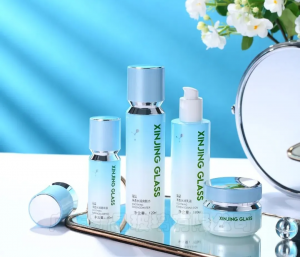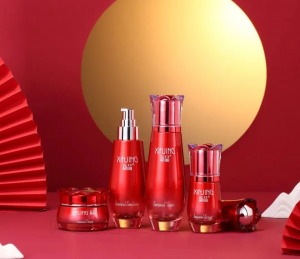Introduction: The main features of glass containers are non-toxic and tasteless; transparent materials, free and varied shapes, beautiful surfaces, good barrier properties, airtightness, abundant and common raw materials, affordable prices, and multiple turnover. It also has the advantages of heat resistance, pressure resistance, and cleaning resistance. It can be sterilized at high temperatures and stored at low temperatures to ensure that the contents will not deteriorate for a long time. It is precisely because of its many advantages that it is widely used in the daily chemical packaging industry.
Product Definition

In the cosmetics industry, packaging products made from raw materials such as quartz sand, limestone, barium sulfate, boric acid, boron sand, and lead compounds, combined with auxiliary materials such as clarifying agents, coloring agents, decolorizing agents, and emulsifiers, processed through drawing, blowing, and other processes are called glass containers or bottles.
Production process
1. Forming process
Firstly, it is necessary to design and manufacture a mold. The glass raw material is mainly quartz sand, which is melted into a liquid state at high temperatures with other auxiliary materials. Then, it is injected into the mold, cooled, cut, and tempered to form a glass bottle

2. Surface treatment
The surface of the glass bottle can be treated with spray coating, UV electroplating, etc. to make the product more personalized. The spraying production line for glass bottles generally consists of a spray booth, a hanging chain, and an oven. For glass bottles, there is also the pre-treatment process, and special attention should be paid to the issue of wastewater discharge. As for the quality of glass bottle spraying, it is related to water treatment, surface cleaning of workpieces, conductivity of hooks, gas volume, amount of powder sprayed, and the level of operators.
3. Graphic printing
On the surface of glass bottles, processes or methods such as hot stamping, high-temperature/low-temperature ink screen printing, and labeling can be used..
product mix
1. Bottle body
Classified by bottle mouth: wide mouth bottle, narrow mouth bottle
Classified by color: plain white, high white, crystalline white, milky white, tea, green, etc.
Classified by shape: cylindrical, elliptical, flat, angular, conical, etc
Common capacities: 5ml, 10ml, 15ml, 20ml, 25ml, 30ml, 50ml, 55ml, 60ml, 75ml, 100ml, 110ml, 120ml, 125ml, 150ml, 200ml
2. Bottle mouth
Common bottle mouths: Ø 18/400, Ø 20/400, Ø 22/400
Conventional (wide mouthed bottle): Ø 33mm, Ø 38mm, Ø 43mm, Ø 48mm, Ø 63mm, Ø 70mm, Ø 83mm, Ø 89mm, Ø 100mm
Bottle (control): Ø 10mm, Ø 15mm, Ø 20mm, Ø 25mm, Ø 30mm
3. Supporting facilities
Glass bottles are often paired with products such as inner plugs, large caps or droppers, droppers, aluminum caps, plastic pump heads, aluminum pump heads, bottle cap covers, etc. Solid paste is generally packaged in wide mouthed bottles, preferably with aluminum or plastic caps. The caps can be used for color spraying and other effects; Emulsion or aqueous paste generally uses narrow mouth bottle, which should be equipped with pump head. If it is equipped with a cover, it needs to be equipped with an inner plug. If it is equipped with an aqueous paste, it needs to be equipped with a small hole as well as an inner plug. If it is thicker, it needs to be equipped with a large hole inner plug.
Procurement precautions
1. Minimum order quantity description:
Due to the manufacturing characteristics of glass (furnaces are not allowed to stop at will), in the absence of stock, the minimum order quantity requirement generally ranges from 30000 to 100000 or 200000
2. Manufacturing cycle
At the same time, the manufacturing cycle is long, usually around 30 to 60 days, and glass has the characteristic that the larger the order, the more stable the quality. But glass bottles also have their drawbacks, such as heavy weight, high transportation and storage costs, and lack of impact resistance.
3. Glass mold fee:
The manual mold costs around 2500 yuan, while the automatic mold usually costs around 4000 yuan per piece. For 1-out 4 or 1-out 8, it costs around 16000 yuan to 32000 yuan, depending on the manufacturer's conditions. The essential oil bottle is usually brown or colored and colored frosted, which can avoid light. The cover has a safety ring, and can be equipped with an inner plug or dropper. perfume bottles are usually equipped with delicate spray pump heads or plastic covers.
4. Printing instructions:
The bottle body is a transparent bottle, and the frosted bottle is a colored bottle called "White Porcelain Bottle, Essential Oil Bottle" (not commonly used color but with high order quantity and less use for professional lines). The spraying effect generally requires an additional 0.5-1.1 yuan per bottle, depending on the area and difficulty of color matching. The silk screen printing cost is 0.1 yuan per color, and cylindrical bottles can be calculated as single color. Irregular bottles are calculated as two or multiple colors. There are usually two types of screen printing for glass bottles. One is high-temperature ink screen printing, which is characterized by not easily fading, dull color, and difficult to achieve purple color matching effect. The other is low-temperature ink screen printing, which has a bright color and high requirements for ink, otherwise it is easy to fall off. In terms of bottle disinfection
Cosmetics application

Glass containers are the second largest category of cosmetic packaging materials,
It can be used in cream, perfume, nail polish, essence, toner, essential oil and other products.
Post time: Oct-22-2024

